The blue eye trait can be found in Siberian Huskies and Australian Shepherds (and related dogs). It can, but does not always do so, cause blue eyes fully unrelated to the dog’s coat color.
Blue Eye Trait Overview
Blue eyes are caused by reduced melanin synthesis, a lack of pigment in the iris.
Traits such as merle or white markings (e.g. from extended piebald or whitehead patterns) can disrupt pigmentation. You probably already know that this can sometimes also affect a dog’s eye color.


In comparison, the ALX4 blue eye trait works no matter the dog’s coat color and only affects eye color. It can cause blue eyes in dogs that are neither merle nor have white across the face.
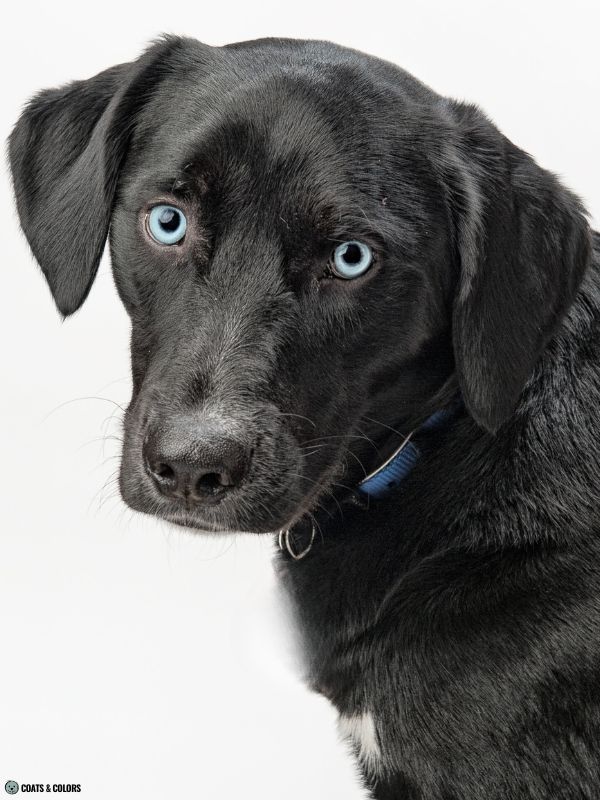

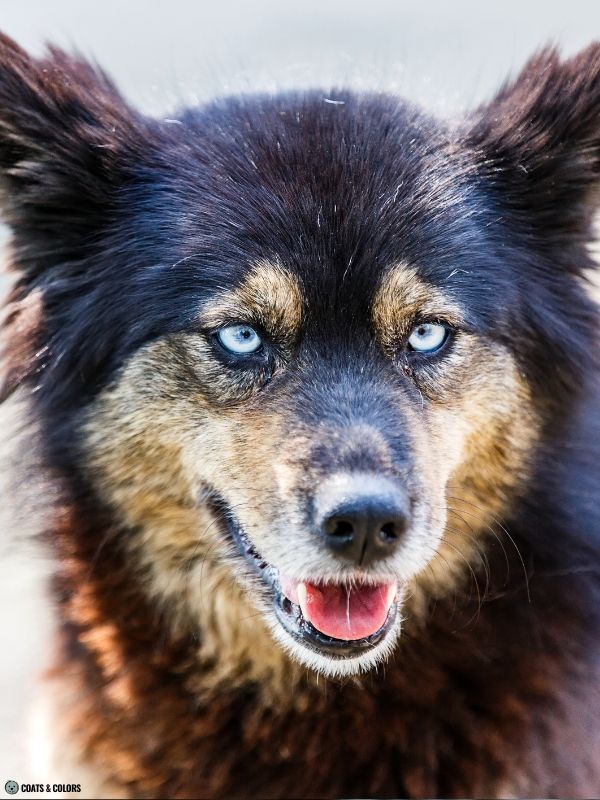
Dogs that express the blue eye trait can have one or two solid blue eyes.
Some dogs even show sectoral heterochromia where only part of their eye color turns blue. Some dogs have a brown eye with just a blue fleck while others have split or marbled eyes.


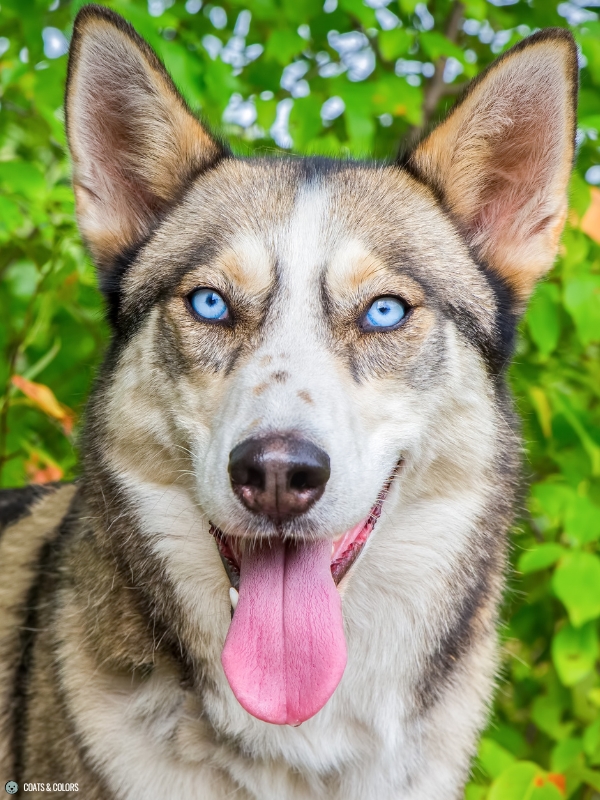
The ALX4 Gene
The blue eye trait is caused by a duplication (an accidental extra copy of some region of DNA) in a regulatory region next to the ALX4 gene (Aristaless-Related Homeobox 4) on dog chromosome 18.
Dogs with one copy of the duplication (N/dup) have a moderate chance of having one or two blue eyes, and dogs with two copies (dup/dup) have a high chance of having one or two blue eyes.
But the blue eye variant is not fully penetrant. This means that quite some dogs with one copy (N/dup) and even a few dogs with two copies (dup/dup) end up with two non-blue eyes.
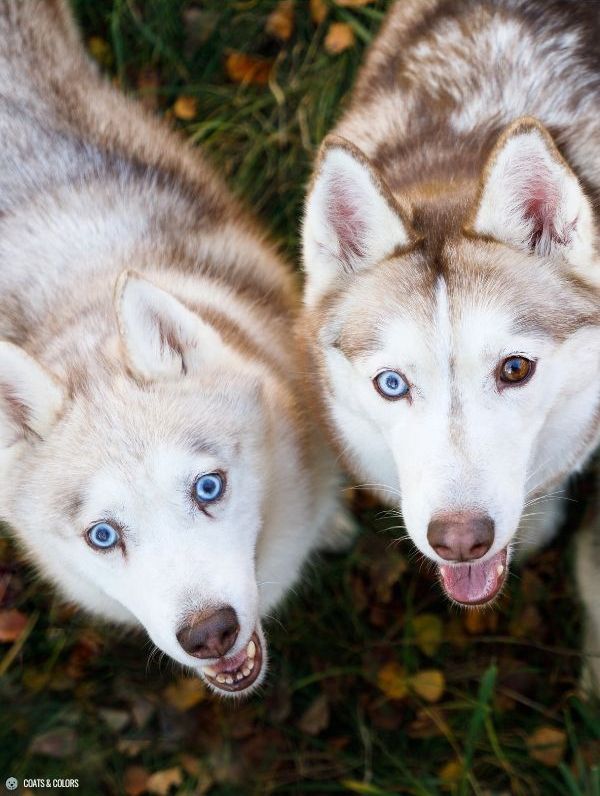
The ALX4 gene plays a role in many aspects of craniofacial development.
In essence, ALX4 is involved in the complex processes required for the formation of body structures during early embryonic development. It is a transcription factor that regulates the activity of other genes, which in turn control cell growth, differentiation, migration, and survival.
ALX4 also plays an important role in mammalian eye development.
And before you ask: The ALX4 blue eye variant is not linked to any health risks. Dogs that have this trait are not more prone to congenital deafness or blindness.
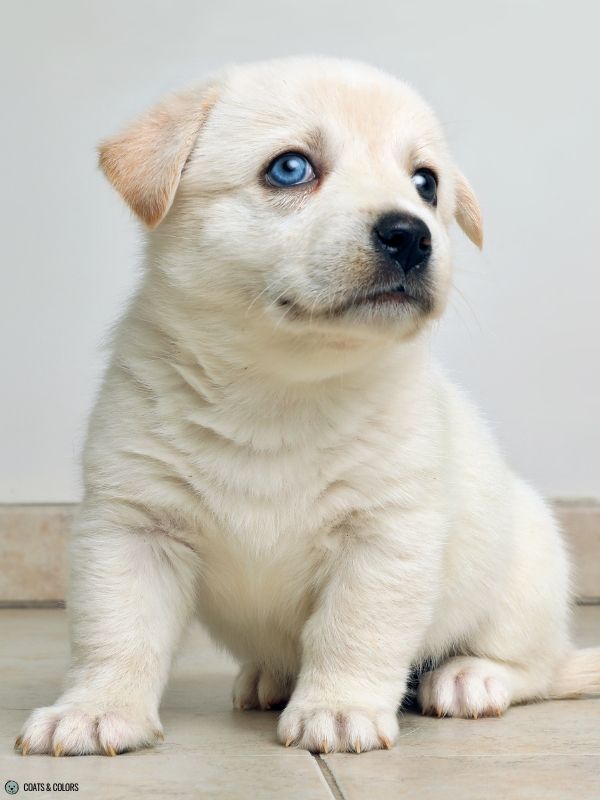
However, the functional mechanism that links the duplication to blue eyes in dogs is not entirely clear.
The study that found the association of ALX4 with blue eyes suggested that the duplication might potentially locally suppress MITF, a gene that controls the development of pigment cells (a mutation in MITF is also responsible for piebald spotting). Impairing MITF function in the pigment epithelium of the retina could potentially lead to a localized reduction of melanin in the iris[1].
“[…] we think that this duplication may disrupt the process by which pigment is deposited in the iris of the eye during development.“
Embark Vet[2]
Blue Eye Trait Genetics
The ALX4 dup mutation is an incomplete dominant trait.
The ALX4 blue eye trait is also not completely penetrant.
This means that not every dog with the duplication will always have blue eyes.
The ALX duplication just genetically predisposes a dog to maybe have blue eyes.
Dogs with one copy (N/dup) can have anything between zero and two blue eyes. Dogs with two copies (dup/dup) are very likely to express at least one blue eye but might in some cases not do so.
Reduced penetrance may be due to some unknown randomness factors or additional genetic modifiers that may override the ALX4 duplication’s effect on eye color.
Interestingly, blue eyes are less likely to be expressed if dogs also have a melanistic mask (Em) allele. Other than that, coat color genes do not affect the expression of the blue eye trait[1].
ALX4 Calculator
This simple tool can help you predict ALX4 combinations and their outcomes.
Dogs with the blue eye variant that do not express blue eyes may still produce blue-eyed puppies. The other way round, blue-eyed dogs can produce brown-eyed puppies.
Dog Breeds with The Blue Eye Trait
The ALX4 duplication was originally found in Siberian Huskies and Australian Shepherds. It also occurs in related breeds such as Alaskan Huskies or the Alaskan Klee Kai or Miniature American Shepherd.


The blue eye variant has been historically present in many of the Northern breeds such as the Yakutian Laika (which also come with extended whitehead patterns, so it can be hard to tell what caused their blue eyes).

Blue eyes can also be found in some popular crosses of these dogs such as the Aussiedoodle or Pomsky.
Also, think of all the other designer dogs and color-bred lines of pet dogs that introduced a merle pattern by breeding some Aussies or Mini Aussie into their lines. These dogs might also have borrowed the blue eye trait and may then produce non-merle dogs with blue eyes.

ALX4 Locus Testing
The blue eye gene only requires one copy to express but is more likely to in dogs that have two copies. But there can be anything from zero to two brown eyes in both cases.
So there’s no way to know if a brown-eyed dog has it without testing.

Embark testing reports if a dog has one copy (N/dup) or two copies (dup/dup) of this trait.
However, they use a linkage test to search for the blue eye color trait in a dog’s DNA.
This means that they do not test for the putative causal mutation.
Instead, the linkage test looks for an unrelated DNA sequence that is known to be consistently physically close enough (linked) to the ALX4 duplication to indicate its presence.
However, in some rare cases, linkage breaks can occur in which case a linkage test is unable to provide reliable results. This happens when the DNA sequence they are testing for “moved out of the neighborhood” of the causative variant and can no longer be used as an indicator.
So there is no 100% guarantee that all results will be entirely accurate.

Different mechanisms can cause blue eyes in dogs, not all of which have been identified.
The presence of the duplication can only explain about 75% of blue-eyed dogs[1].
Some dogs are neither have merle nor white markings, test as N/N for the ALX4 duplication but still have blue eyes. These dogs may have as yet unknown trait that causes their blue eyes.
Sometimes, undetected merle variants might be responsible for blue eyes in dogs with an otherwise solid color pattern. A dog might not have a merle phenotype but some variants in the merle allelic series do not necessarily express in the coat while still sometimes causing blue eyes.
Also, some coat color patterns (clear sable, recessive red, extended white) can hide merle.

And dogs don’t always need super excessive face white to get blue eyes. It’s just more likely to happen if a dog has a split face or other more extended white face markings.
But some dogs with just enough face white occasionally end up with blue eyes because whatever disrupted their coat color sometimes manages to affect their eye color. There are many examples of Bernese Mountain Dogs or Springer Spaniels or Corgis with not that much face white but a blue eye.
And then there are of course puppy blue eyes and naturally light eyes in dogs with color dilution.
Learn More
Links
[1] Deane-Coe, Chu, Slavney, Boyko, Sams (2018): Direct-to-consumer DNA testing of 6,000 dogs reveals 98.6-kb duplication associated with blue eyes and heterochromia in Siberian Huskies. PLoS Genet 14. https://doi.org/10.1371/journal.pgen.1007648
[2] Aaron Sams (PhD): Embark Discovers Why Dogs Have Blue Eyes. Last Updated: June 2023

Hi! I’m Steffi. I am a biologist and a big time dog nerd. You are curious about coat color genetics? You’ve come to the right place! Read more.







